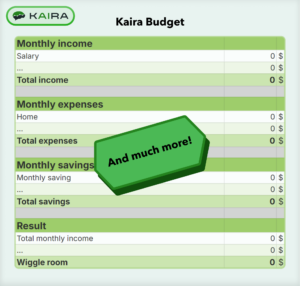In a world where financial pressures can quickly disturb personal and professional life, financial well-being is more important than ever. Effectively managing debt is not just a question of money, but also of mental health and daily serenity. Promoting responsible management of personal finances as an employer can transform employees’ quality of life, boost motivation and, in return, optimize productivity.
However, it is important to distinguish between an investment debt and a consumption debt. This is a crucial first step in establishing an effective financial plan. Investment debt, such as a loan for real estate, is generally seen as “healthy”, since it can generate income or value. Conversely, consumer debt (credit cards, consumer credit) represents a long-term burden with no financial return and must be addressed as a priority to avoid spiralling into debt.
A well-structured budget and realistic financial goals can transform the approach to debt management. Here’s a practical guide to help develop a clear, structured debt reduction plan.
Step 1: Assess debts and set priorities
A complete debt inventory lays a solid foundation for future financial decisions. Write down each debt with:
- Total amount owed
- Interest rate
- Repayment period
Next, classify your debts according to their interest rate or potential impact. For example:
- High priority: High-rate consumer debt (credit cards, personal loans)
- Moderate priority: Low-interest loans (student loans, car loans)
- Low priority: Investment loans generating a financial return
Step 2: Create a realistic, structured budget
A budget is the fundamental tool for all debt management. First, calculate the monthly income and fixed expenses (housing, insurance, transportation) and identify the monthly amount that can be devoted to debt repayment.

Winning tips for an effective budget:
- Allocate a specific amount to debt repayment each month, setting a realistic percentage to avoid over-indebtedness.
- Automate payments to avoid delays and penalties.
- Include funds for contingencies (5-10% of income), as this reduces the need to take on new debt in the event of unexpected expenses.
Step 3: Choose a debt reduction strategy
A clear debt reduction plan is essential. Here are two popular and effective methods:
- Snowball method: we can achieve quick wins by encouraging the repayment of small debts first, which motivates to continue the process.
- Avalanche method: By paying off debts with the highest interest rates first, we can save money in the long run. This option is best suited to individuals who are prepared to make return-based financial decisions.
Step 4: Use available resources to lighten the debt burden
Options for optimizing debt repayment:
- Interest rate renegotiation: contacting creditors to negotiate more favorable rates can ease the repayment burden.
- Debt consolidation: we can simplify debt management and reduce interest by grouping several debts under a single loan at a reduced rate.
Helping your employees manage their debt responsibly is a winning investment. Consider introducing financial coaching programs, educational resources or benefits tailored to your teams’ needs, to deepen your financial wellbeing efforts. This not only strengthens their financial health, but also their company engagement.
Encouraging structured, informed debt management makes you a trusted partner in your employees’ quest for financial stability, and helps build a healthy, motivating work environment.
Need personalized guidance to plan your home purchase? A financial advisor can help structure your strategy and make informed decisions.


